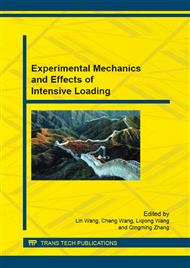p.252
p.261
p.271
p.278
p.291
p.296
p.302
p.311
p.316
Numerical Simulation of Damage Effective of Explosion in Buildings
Abstract:
The software AUTODYN is used to investigate the damage mechanism of explosion in the brick and concrete buildings with different mass of charge in this paper. The results show that the mesh size of 5mm is very appropriate to study internal explosion; the maximum pressure area in the junction between roof and wall is broken up first and has the highest velocity, where is far from explosion source; the internal explosion damage in brick and concrete buildings appears in the boundaries between walls and roof.
Info:
Periodical:
Pages:
291-295
Citation:
Online since:
August 2015
Authors:
Keywords:
Price:
Сopyright:
© 2015 Trans Tech Publications Ltd. All Rights Reserved
Share:
Citation:


